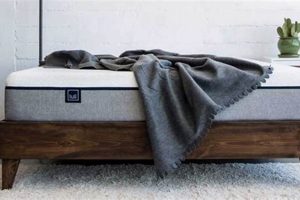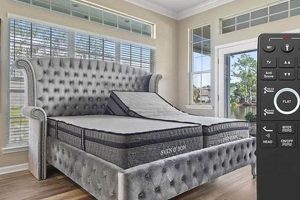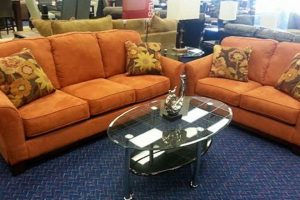Selection of home furnishings and bedding represents a significant investment in comfort and aesthetic appeal. This encompasses a wide variety of items, ranging from sofas and tables to beds and associated sleep products. The goal is to create living spaces that are functional, stylish, and conducive to relaxation.
Carefully chosen furnishings and bedding can greatly enhance the quality of life. Comfortable seating promotes relaxation and social interaction. Supportive mattresses contribute to restful sleep, impacting physical and mental well-being. Furthermore, the style and arrangement of these items influence the overall ambiance of a home, reflecting the homeowner’s personal taste and creating a welcoming environment.
The following sections will delve into specific aspects of selecting durable, aesthetically pleasing, and ergonomically sound furnishings and bedding. Considerations such as material quality, design trends, and budgetary constraints will be examined to provide a comprehensive understanding of the decision-making process.
Guidance for Furnishing and Bedding Selection
The following guidelines offer practical advice for choosing high-quality, long-lasting, and aesthetically appropriate items for the home.
Tip 1: Prioritize Material Durability: Assess the quality and resilience of materials. Solid wood construction, reinforced frames, and high-density foams contribute to longevity. Consider fabrics with high abrasion resistance ratings for upholstery.
Tip 2: Evaluate Construction Techniques: Examine the craftsmanship involved in manufacturing. Dovetail joints, corner blocks, and hand-tied springs indicate superior construction. Ensure seams are securely stitched and hardware is robust.
Tip 3: Assess Ergonomic Design: Prioritize comfort and support. Seating should provide adequate lumbar support. Mattresses should conform to the body’s natural curves and alleviate pressure points. Consider adjustable features for enhanced customization.
Tip 4: Consider Space Planning: Measure available space accurately and select items that fit proportionally. Avoid overcrowding rooms. Utilize scale models or online planning tools to visualize arrangements.
Tip 5: Invest in Classic Designs: Opt for timeless styles that transcend fleeting trends. Neutral colors and simple silhouettes offer versatility and adaptability to changing decor schemes. Consider items that can be easily reupholstered or refinished.
Tip 6: Research Brand Reputation: Investigate manufacturer’s reputation for quality and customer service. Read reviews and seek recommendations from trusted sources. Inquire about warranties and return policies.
Tip 7: Budget Appropriately: Establish a realistic budget and allocate funds strategically. Prioritize essential items and consider purchasing higher-quality pieces that will withstand the test of time.
Adhering to these principles ensures the selection of furnishings and bedding that offer lasting value, comfort, and aesthetic appeal, creating functional and inviting living spaces.
The subsequent sections will address specific considerations for different rooms and types of furnishings.
1. Durability
Durability, in the context of furnishings and bedding, directly influences the longevity and cost-effectiveness of these items. The selection of materials and construction techniques determines how well furniture and mattresses withstand daily use, resist wear and tear, and maintain their structural integrity over time. Substandard materials or poor craftsmanship result in premature degradation, necessitating frequent replacement, which significantly increases the overall cost of ownership. Conversely, durable furnishings and bedding represent a long-term investment, providing years of reliable service and minimizing the need for costly repairs or replacements.
For example, a sofa constructed with a solid hardwood frame and high-density foam cushions will typically outlast a sofa with a particleboard frame and low-density foam. Similarly, a mattress with individually wrapped coils and reinforced edges will provide better support and resist sagging compared to a mattress with a simple innerspring system. Consider the impact of fabric selection: a tightly woven, stain-resistant fabric will endure daily use more effectively than a delicate, loosely woven material. In commercial settings, where furniture and bedding experience high traffic and heavy use, durability becomes even more critical to minimize maintenance and replacement costs.
Understanding the correlation between durability and the overall value of furnishings and bedding allows for informed purchasing decisions. While initial costs may be higher for more durable items, the long-term savings and reduced environmental impact associated with fewer replacements make it a worthwhile investment. Focusing on durability, therefore, aligns with the concept of selecting high-quality, long-lasting items that contribute to both comfort and financial well-being.
2. Ergonomics
Ergonomics plays a central role in defining the characteristics of optimal furnishings and bedding. The discipline focuses on designing products and environments that accommodate the human body, minimizing strain and maximizing comfort and efficiency. In the context of furniture and mattresses, ergonomic design translates to items that promote proper posture, support natural spinal alignment, and reduce pressure points. The absence of ergonomic considerations can lead to discomfort, pain, and potential long-term health issues, thereby diminishing the overall quality of life.
For example, a chair with inadequate lumbar support may contribute to back pain, while a mattress that is too firm or too soft can disrupt sleep patterns and cause muscle stiffness. Conversely, an ergonomically designed chair would feature adjustable height, armrests, and lumbar support to accommodate individual body types and promote correct posture. Similarly, a mattress constructed with zoned support and pressure-relieving materials would conform to the body’s contours, minimizing tossing and turning and promoting restful sleep. The selection of appropriate ergonomic furniture in a home office setting, for instance, can significantly improve productivity and reduce the risk of repetitive strain injuries.
Prioritizing ergonomic features in the selection of furnishings and bedding necessitates a comprehensive understanding of individual needs and preferences. Body weight, sleeping position, and pre-existing medical conditions all influence the optimal choice. Investment in ergonomic products, while potentially requiring a higher initial expenditure, translates to long-term benefits in terms of improved comfort, reduced pain, and enhanced overall well-being. Ergonomics, therefore, represents a vital component in the pursuit of superior furnishings and bedding and its impact on physical health.
3. Aesthetics
Aesthetics, in the context of furnishings and bedding, represents a crucial element contributing to the overall appeal and atmosphere of a living space. While durability and ergonomics address functionality and comfort, aesthetics concerns the visual and tactile properties that evoke emotional responses and reflect personal style. Furnishings and bedding that are aesthetically pleasing enhance the perceived quality of life, creating a sense of harmony and well-being within the home environment. The impact of aesthetics is not merely superficial; it directly influences mood, relaxation, and social interaction within the living space.
The choice of color palettes, textures, and styles significantly impacts the ambiance of a room. For example, a minimalist aesthetic with neutral tones and clean lines may create a sense of calm and order, while a more vibrant and eclectic style can foster creativity and energy. The careful selection of fabrics, finishes, and decorative elements contributes to the overall visual coherence and reinforces the desired atmosphere. In a bedroom, for example, the choice of bedding including sheets, comforters, and pillows can greatly influence the perception of comfort and luxury. A well-coordinated aesthetic creates a cohesive and inviting space.
Ignoring aesthetics can lead to a discordant and uninviting living environment, negatively affecting mood and overall satisfaction. However, achieving a pleasing aesthetic requires careful consideration of personal preferences, spatial constraints, and the existing architectural features of the home. The integration of aesthetic considerations alongside durability and ergonomics is vital to create superior furnishings and bedding that provide both functional and emotional value and that contributes to a harmonious living space.
4. Value
Value, within the context of superior furnishings and bedding, represents a synthesis of several key factors: initial cost, long-term durability, functional performance, aesthetic appeal, and potential health benefits. The perception of value arises when the benefits derived from these items outweigh the financial investment required for their acquisition. A low initial price point, while seemingly attractive, does not necessarily equate to superior value if the item lacks durability, performs poorly, or compromises health. Conversely, a higher initial investment in durable, ergonomically sound, and aesthetically pleasing furnishings and bedding can provide greater long-term value by reducing replacement costs, improving comfort, and enhancing the overall living experience. The assessment of value, therefore, demands a holistic perspective that considers the total cost of ownership and the comprehensive range of benefits derived.
Consider the example of mattress selection: a less expensive mattress may offer short-term comfort but degrade rapidly, leading to premature sagging and discomfort. This necessitates earlier replacement, increasing the total cost over time. In contrast, a higher-priced mattress constructed with durable materials and advanced support systems may maintain its integrity for a significantly longer period, providing consistent comfort and support, and ultimately proving more cost-effective in the long run. This highlights the importance of considering the lifecycle cost, not just the initial purchase price. Similarly, a well-crafted wooden dining table, though initially more expensive than a mass-produced alternative, may last for generations, becoming a family heirloom and negating the need for frequent replacements. These examples illustrate how focusing solely on the initial price can be a misleading indicator of true value.
In conclusion, the concept of value in superior furnishings and bedding transcends mere monetary considerations. It encompasses a comprehensive evaluation of durability, functionality, aesthetics, and potential health benefits. A discerning approach that prioritizes long-term performance and overall well-being results in more informed purchasing decisions and ensures that the investment in furnishings and bedding delivers lasting value and enhances the quality of life. Recognizing this multifaceted nature of value is vital for consumers seeking the best possible return on their investment and the creation of comfortable and functional living spaces.
5. Health
The connection between health and the selection of superior furnishings and bedding is substantive and multifaceted. The composition of materials, the structural design, and the ergonomic attributes of furniture and mattresses exert a direct influence on physical well-being. Specifically, the off-gassing of volatile organic compounds (VOCs) from certain furniture finishes and mattress foams can negatively impact respiratory health. Furthermore, inadequate support from mattresses or seating can contribute to musculoskeletal problems, including back pain and poor posture. The selection of hypoallergenic materials and ergonomically sound designs is therefore paramount in mitigating these potential adverse effects and promoting a healthy living environment.
Consider, for example, the impact of mattress selection on sleep quality. Mattresses constructed with memory foam or latex can conform to the body’s contours, alleviating pressure points and promoting spinal alignment. This, in turn, contributes to more restful sleep, which is essential for physical and cognitive restoration. Conversely, mattresses with inadequate support can lead to restless sleep, muscle stiffness, and chronic back pain. Similarly, the selection of office chairs with adjustable lumbar support and armrests can mitigate the risk of repetitive strain injuries and promote proper posture during prolonged periods of sitting. The practical significance of this understanding lies in the ability to make informed purchasing decisions that prioritize health and well-being.
In summary, the selection of furnishings and bedding represents a critical investment in long-term health. Prioritizing materials with low VOC emissions, ergonomic designs that promote proper posture and support, and hypoallergenic properties to minimize allergic reactions are essential considerations. While challenges remain in navigating the complex landscape of product certifications and marketing claims, a commitment to informed decision-making and a focus on health-related attributes will yield significant benefits in terms of improved comfort, enhanced well-being, and a healthier living environment. Recognizing this relationship elevates the purchase beyond a mere transaction to a proactive investment in personal health.
Frequently Asked Questions About Furniture and Bedding Selection
The following section addresses common inquiries and clarifies key considerations related to choosing furnishings and bedding. These responses aim to provide clear, informative guidance to aid in the selection process.
Question 1: What factors determine the durability of furniture?
The durability of furniture is contingent upon several elements, including the type and quality of materials used in construction, the joinery techniques employed, and the protective finishes applied. Solid wood frames, reinforced joinery (such as dovetail joints), and high-quality upholstery fabrics typically contribute to enhanced durability. Particleboard or MDF construction, stapled joints, and thin, easily damaged finishes generally indicate lower durability.
Question 2: How does mattress construction affect sleep quality?
Mattress construction significantly impacts sleep quality by influencing support, pressure relief, and temperature regulation. Mattresses with individually wrapped coils or pocketed coils offer superior support and minimize motion transfer. Memory foam and latex conform to the body’s contours, alleviating pressure points. Breathable materials, such as open-cell foam or natural fibers, promote airflow and regulate temperature, preventing overheating during sleep.
Question 3: What are the potential health implications of VOCs in furniture?
Volatile organic compounds (VOCs) emitted from certain furniture finishes, adhesives, and foams can pose health risks, particularly for individuals with respiratory sensitivities. Exposure to VOCs can trigger allergic reactions, respiratory irritation, and other adverse health effects. Opting for furniture with low-VOC or zero-VOC certifications minimizes these potential risks.
Question 4: How can ergonomic principles be applied to furniture selection?
Ergonomic principles dictate that furniture should be designed to support proper posture, minimize strain, and promote comfort. Chairs should offer adjustable height, lumbar support, and armrests. Desks should be positioned at an appropriate height to prevent slouching. Mattresses should conform to the body’s natural curves and provide adequate support to maintain spinal alignment.
Question 5: What are the key considerations for selecting furniture for small spaces?
When selecting furniture for small spaces, prioritize multifunctional items that serve multiple purposes. Opt for furniture with built-in storage to maximize space utilization. Choose light colors and streamlined designs to create a sense of openness. Measure available space accurately to ensure that furniture fits proportionally.
Question 6: How can the environmental impact of furniture purchases be minimized?
The environmental impact of furniture purchases can be reduced by selecting items made from sustainably sourced materials, such as reclaimed wood or bamboo. Look for furniture with eco-friendly certifications, such as Forest Stewardship Council (FSC) certification. Consider purchasing used or vintage furniture to reduce the demand for new resources. Dispose of old furniture responsibly by donating or recycling it whenever possible.
These FAQs highlight critical factors in ensuring informed selections, optimizing for durability, comfort, and health, while considering spatial and environmental aspects.
The following section will delve into specific material considerations for furniture and mattresses.
Conclusion
The preceding exploration has emphasized that the selection of superior furnishings and bedding is a multifaceted undertaking. Considerations extend beyond mere aesthetic preference and encompass critical aspects such as material durability, ergonomic design, health implications, and overall value. A thorough assessment of these factors is essential for informed decision-making and ensuring long-term satisfaction with the chosen items. Focusing on one attribute while neglecting others can undermine the overall benefit and lead to premature replacement or compromised well-being.
Ultimately, the acquisition of furnishings and bedding represents a significant investment in the quality of life. Prioritizing informed choices, based on the principles of durability, ergonomics, aesthetics, value, and health, enables the creation of living spaces that are both functional and conducive to a sense of well-being. Continuing research and awareness regarding product specifications and long-term performance remain crucial for maintaining a discerning approach to purchasing decisions in this domain.







